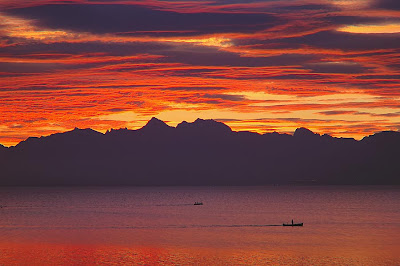You think landscapes are static ... geological even. Not much changes, and there's plenty of time to set up your camera, compose a shot and maybe make a cup of tea whilst considering your composition.
Think again.
Whilst landscapes don't move as fast as a Formula 1 Ferrari, things change pretty quickly, especially at dawn and dusk.
I took this photograph on the shores of Lac Léman (Lake Geneva) at dawn one October morning. This is the way it was ... no red filter used or Photoshop manipulation. I have increased the saturation a little (as digital cameras give duller images than film) and tweaked the dynamic range (because digital cameras don't handle this so well either). But apart from that, nothing.

I'd been there, in that spot, for about 45 minutes before capturing this shot. In fact, I heard the fishermen start up their boat engines in a nearby port, and prayed that they would set out in my direction, at the right moment. They did! (I don't always get so lucky.)
There was a hotel behind me. Shortly before I took this shot a man threw open a bedroom window peered out and saw the scene.
Five minutes later he'd emerged from the hotel, still pulling on his sweater, with a camera in his hand.
But by then the light was pinkish, and only mildly pretty. The drama had gone ...
... and so had the fishermen.
Think again.
Whilst landscapes don't move as fast as a Formula 1 Ferrari, things change pretty quickly, especially at dawn and dusk.
I took this photograph on the shores of Lac Léman (Lake Geneva) at dawn one October morning. This is the way it was ... no red filter used or Photoshop manipulation. I have increased the saturation a little (as digital cameras give duller images than film) and tweaked the dynamic range (because digital cameras don't handle this so well either). But apart from that, nothing.

I'd been there, in that spot, for about 45 minutes before capturing this shot. In fact, I heard the fishermen start up their boat engines in a nearby port, and prayed that they would set out in my direction, at the right moment. They did! (I don't always get so lucky.)
There was a hotel behind me. Shortly before I took this shot a man threw open a bedroom window peered out and saw the scene.
Five minutes later he'd emerged from the hotel, still pulling on his sweater, with a camera in his hand.
But by then the light was pinkish, and only mildly pretty. The drama had gone ...
... and so had the fishermen.




3 comments:
gorgeous!
"Tweaking the dynamic range"?
please explain!
Ah ... sorry Catherine. Jargon.
The dynamic range is the difference between the light parts and the dark parts of an image. One time when this often gives problems is at sunrise/sunset when there is a huge difference between the bright sky and the dark land. Digital cameras are worse at dealing with this than good old film.
What happens is that if you set the exposure correctly for the sky, the land will be featureless black, but if you expose correctly for the land the sky gets burned-out.
In this picture I set the exposure for the sky and 'tweaked' the mountains and water a little (brought up the exposure) using software.
Another, and better, way of doing it is to use a graduated neutral density filter when you take the photo. This is a filter that fits in front of the lens which shades from a neutral black at the top to completely clear at the bottom. In other words it cuts the light from the sky (without changing its colour ... hence the 'neutral') but does not affect the land.
I didn't own such a filter when I took this photo. I do now.
Post a Comment